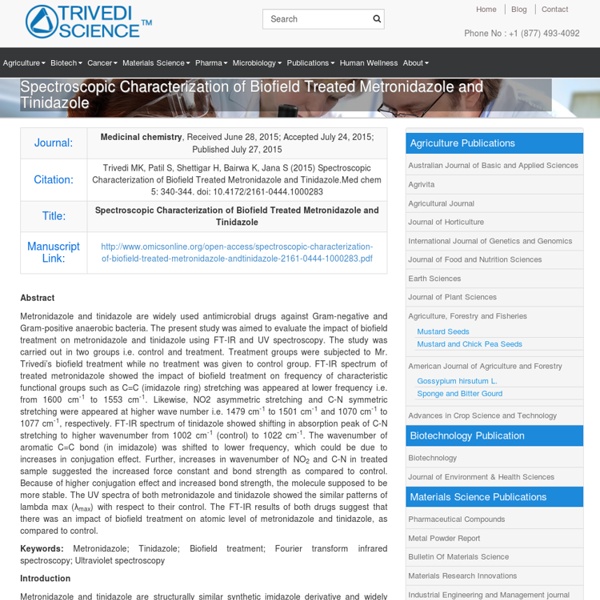Structural and Physical Properties of Biofield Treated Thymol and Menthol
Abstract Thymol and menthol are naturally occurring plant derived compounds, which have excellent pharmaceutical and antimicrobial applications. The aim of this work was to evaluate the impact of biofield energy on physical and structural characteristics of thymol and menthol.
Biofield Treated Bile Salt and Proteose Peptone
Abstract Bile salt (BS) and proteose peptone (PP) are important biomacromolecules being produced inside the human body. The objective of this study was to investigate the influence of biofield treatment on physicochemical properties of BS and PP. The study was performed in two groups (control and treated). The control group remained as untreated, and biofield treatment was given to treated group.
Human Biofield’s Influence on Properties of Indole
Abstract Indole compounds are important class of therapeutic molecules, which have excellent pharmaceutical applications. The objective of present research was to investigate the influence of biofield treatment on physical and thermal properties of indole. The study was performed in two groups (control and treated). The control group remained as untreated, and biofield treatment was given to treated group.
Characterization of Biofield Energy Treated 3-Chloronitrobenzene: Physical, Thermal, and Spectroscopic Studies
The chloronitrobenzenes are widely used as the intermediates in the production of pharmaceuticals, pesticides and rubber processing chemicals. However, due to their wide applications, they are frequently released into the environment thereby creating hazards. The objective of the study was to use an alternative strategy i.e. biofield energy treatment and analysed its impact on the physical, thermal and spectral properties of 3-chloronitrobenzene (3-CNB).
"Antimicrobial Sensitivity Pattern of Pseudomonas fluorescens after Bio" by Mahendra Kumar Trivedi
Abstract Global emergence of Pseudomonas fluorescens (P. fluorescens) displays a mechanism of resistance to all existing antimicrobials. Due to its strong ability to acquire resistance, there is a need of some alternative treatment strategy. Objective of this study was to investigate the effect of biofield treatment on antimicrobial sensitivity pattern of P. fluorescens. P. fluorescens cells were procured from MicroBioLogics in sealed packs bearing the American Type Culture Collection (ATCC 49838) number. Two sets of ATCC samples were taken in this experiment and denoted as A and B.
Biofield Treatment on Hydroxyethyl and Hydroxypropyl Cellulose
Abstract Cellulose based polymers have shown tremendous potential as drug delivery carrier for oral drug delivery system (DDS). Hydroxyethyl cellulose (HEC) and hydroxypropyl cellulose (HPC) are widely explored as excipients to improve the solubility of poorly water soluble drugs and to improve self-life of dosage form. This work is an attempt to modulate the physicochemical properties of these cellulose derivatives using biofield treatment.
Effect of Biofield Energy Treatment on Streptococcus group B: A Postpartum Pathogen
Abstract Streptococcus agalactiae group B (S. agalactiae gr. B) is widespread in nature mainly causes bacterial septicemia and neonatal meningitis. The current study was attempted to investigate the effect of biofield treatment on S. agalactiae gr.
"An Effect of Biofield Treatment on Multidrug-resistant Burkholderia ce" by Mahendra Kumar Trivedi
Abstract Burkholderia cepacia (B. cepacia) is an opportunistic, Gram negative pathogen which causes infection mainly in immunocompromised population and associated with high rate of morbidity and mortality in cystic fibrosis patients. Aim of the present study was to analyze the impact of biofield treatment on multidrug resistant B. cepacia. Clinical sample of B. cepacia was divided into two groups i.e. control and biofield treated. The analysis was done after 10 days of treatment and compared with control group. Control and treated group were analyzed for susceptibility pattern, MIC value, biochemical studies and biotype number using MicroScan Walk-Away® system.



